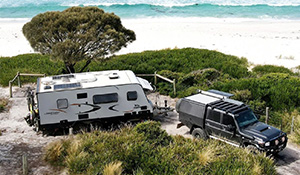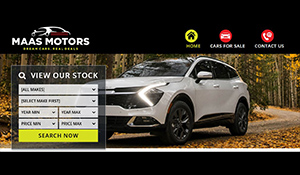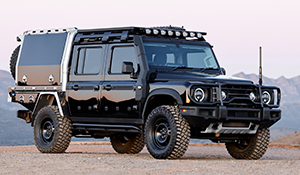The Great Escape?
THE FORD ESCAPE (nee Kuga) is based on Ford’s Focus hatchback platform, so it’s kind of born with pretty good genes. Made in Germany, the Escape is pure compact SUV, from the way it looks to the way it drives. Which means, of course, that it’s some kind of a bullseye in today’s SUV-hungry market.
The big changes are the move to shift paddles for the automatic versions, an electronic park-brake and an upgrade to connectivity and entertainment. Ford is also quick to point out that the Escape is the only car in its class to offer sat-nav and dual-zone air-conditioning across the board. The top-shelf Titanium model now gets Xenon headlights (pictured).
Perhaps the biggest change with the move from Kuga to Escape (in a marketing sense, anyway) is that Ford can now offer the SUV in a mid-spec trim level with a petrol engine, automatic transmission and front-wheel-drive (as opposed to all-wheel drive). Despite Ford’s global sourcing, that’s a specification the Kuga just never offered. And since that layout seems to be the sweet spot as far as buyers are concerned, the new Trend front-drive auto variant looks to be the great white hope. Maybe even the great Escape.

What’s the interior like and how practical is it?
If you’ve ever sat in a current-model Focus, you’ll feel right at home in the Escape. The hooded binnacle screams Focus and everything from the new centre-stack to the blue needles on the instruments is all identifiably Focus-sourced. Frankly, that means things look a bit fussy and busy, to us. There are cleaner designs around and while it’s commendable that Ford has done its own thing (rather than simply ape VW’s interior presentation as nearly everybody else has) it lacks that final lick of polish in terms of its layout.
The seats are good (even better if you pony up for leather) and while the materials seem to be of decent quality, like the dashboard, there seems to be a lot of angles and splashes going on even in the door trims. Access to the rear seat is perfectly okay but the seat cushion itself is a bit flat for some tastes. But parents will appreciate the high ride-height which makes strapping kids into restraints much easier in the back – a major selling point for any SUV.
Load space is good and about what you’d expect for a car like this. The only problem there is that some buyers seem to think the bulkier exterior (over a hatchback) automatically means more interior space. The Escape is not alone here, but it aint necessarily so.
Ford’s Sync 3 is now standard on all Escapes and offers a top-rung solution to connectivity, voice-command and the standard sat-nav. A large 8.0-inch touch-screen (across all variants) serves as the interface and is mounted high and handy.

What’s it like on the road?
This is where the Escape scores some points over much of its opposition. The ride is firm, but even with the low-profile 19-inch tyres on the Titanium model we sampled, it doesn’t turn nasty on typically lumpy back-roads bitumen. The all-wheel drive system on the Titanium also dials out any torque-steer and creates huge grip, making the Escape feel very secure.
The steering is a highlight, too. It’s sharp and feels as though it has a pretty fast ratio, but there’s no kick-back or banging noises even when you clobber a big bump mid-corner with the power on. It feels accurate through the helm, too, although the feel and feedback generated by the electric power-steering system strikes you as a bit CGI when you wanted live action. But the first thing most people will notice is that the Escape feels long and narrow - almost like how you’d imagine it’s like to steer a canal boat - with the nose a long way out front. It is, of course, just an impression; probably down to the relationship between the driver’s seat, the base of the windscreen and the car’s rising waistline. And, hey, it’s another point of difference.
Our Titanium model had the two-litre Ecoboost turbocharged four-cylinder petrol engine which is good for 178kW and is tied to a six-speed automatic transmission. That sounds like a lot of kiloWatts, but bear in mind that the Escape in this form weighs in at a chunky 1700kg-plus, about the same as a 10-year-old Holden Commodore. That takes the edge off the acceleration then, downgrading it from `neck-snapping’ to just `plenty’.
The engine sounds like it’s enjoying itself under load, too, and as the turbocharger builds boost, the Escape just gets stronger and musclier as revs rise. But even at low engine speeds, there’s enough oomph to make the Ford feel relaxed and reasonably effortless, so it’ll be a capable interstater or urban runabout, even with a load of bodies and baggage on board.
The brakes are strong and the whole car has a very resolved feel to the way it drives. And that’s not a gimme in compact SUVs where the dynamic compromises of jacking up a hatchback are sometimes all too visible. In the Escape, they’re not.

What about the safety features?
The Escape scores well here with seven air-bags, including side-curtain air-bags that cover all seating positions. There’s a driver’s-knee air-bag, too, but it’s worth noting that car-makers only usually add a knee-bag if the car needs it to score five stars in crash testing. According to Ford, the Escape is currently being tested by ANCAP, but no scores are available yet.
There’s a standard reversing camera on all variants as well as the full raft of driver-assistance and braking technologies on all models. The Titanium’s standard Active City Braking now works at speeds up to 50km/h. The Titanium also gets lane-assist which physically steers the car for you if you stray over the white lines (provided there are white lines) but many will turn this function off as it’s a little disconcerting.

Why would you buy one?
Well, probably ‘because it’s an SUV’ would be enough of a reason for our SUV-hungry market. But, there’s more to the Escape than ‘just being an SUV’, because it’s a good car to drive with, in the top-spec Titanium we tested, all-wheel drive to keep it feeling nice and secure. There’s reasonable room inside, and while the materials used and the fit and finish is excellent, the design might not be too everyone’s taste. The Escape is a front-runner in this segment, but it’s not the best.

2017 Ford Escape
Pricing From $28,490+ORC
Warranty three years, 100,000km
Safety Not yet tested
Engine 1.5L four-cylinder petrol (two outputs); 2.0L turbocharged four-cylinder petrol; 2.0L turbocharged four-cylinder diesel
Power/Torque 110kW/240Nm; 134kW/240Nm; 178kW/345Nm; and 132kW/400Nm
Transmission six-speed manual; six-speed automatic
Dimensions 4523mm (L); 2077mm (W - with mirrors); 1684mm (H)
Spare Space saver
Fuel Tank 60L
Thirst 5.5-8.6L/100km
Hans Offmibier

















